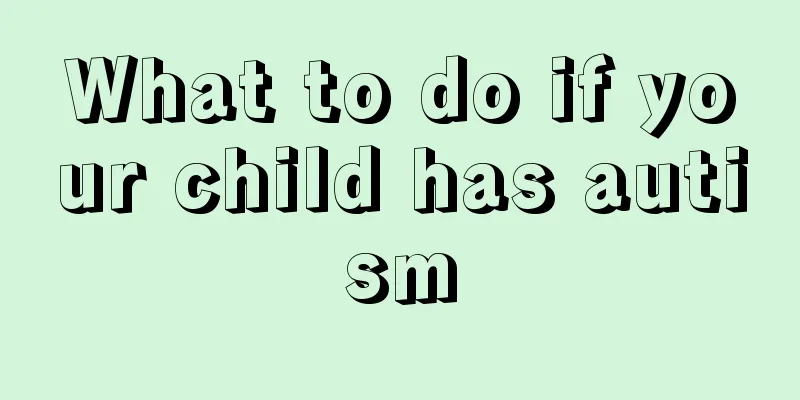What to do if your child has autism

|
You can tell a lot about a child's future at the age of three and his old age at the age of seven. The education a child receives at different stages and the influence of his surroundings may affect his entire life. Autism is a mental illness that often occurs in children. We all hope that our children can grow up happily, but children with autism will immerse themselves in their own world and refuse to speak or socialize. If your child has autism, you must not be anxious, as autism requires long-term treatment. Autism is a subtype of pervasive developmental disorder, which is more common in males. It begins in infancy and is mainly manifested by varying degrees of speech development disorders, interpersonal communication disorders, narrow interests and stereotyped behaviors. Clinical manifestations 1. Language Barrier Language and communication disorders are important symptoms of autism and the main reason why most children seek medical treatment. Language and communication disorders can manifest in many forms. Most children with autism have delayed or impaired language development. They usually still cannot speak at the ages of two and three, or they experience language regression after normal language development. They have expressive language before the age of 2 to 3 years, which gradually decreases with age or is even lost completely. They remain silent for life or, in rare cases, use limited language. They have some degree of obstacles in their perception and expression of language. 2. Social interaction disorder The patient is unable to establish normal interpersonal relationships with others. When they are young, they do not make eye contact with others, have a dull expression, lack the expression or gesture of expecting hugs and caresses from their parents or others, and have no happy expression when enjoying caresses, and even reject hugs and caresses from their parents and others. He cannot distinguish between close and distant relationships and treats his relatives with the same attitude as he treats other people. Unable to establish a normal attachment relationship with parents, patients have difficulty establishing normal partnerships with children of the same age. For example, they tend to stay alone in kindergarten and do not like to play with their peers. When they see some children playing games enthusiastically together, they have no interest in watching or desire to participate. 3. Narrow interests and stereotyped behavior patterns The patient is not interested in the games and toys that normal children are keen on, but likes to play with non-toy objects, such as a bottle cap, or observe the rotating electric fan, etc., and can last for dozens of minutes or even several hours without feeling bored. Not interested in the main features of toys, but very concerned about non-main features: patients stubbornly require to keep the daily activity routine unchanged, such as going to bed at the same time, covering the same quilt, taking the same route when going out, etc. If these activities are stopped or behavioral patterns are changed, the patient will express obvious unhappiness and anxiety, and even engage in rebellious behavior. Patients may have repetitive stereotyped movements, such as clapping their hands, turning in circles, licking the wall with their tongue, stomping their feet, etc. 4. Intellectual Disability Among children with autism, the intelligence levels are very inconsistent. A few patients are within the normal range, while most patients show varying degrees of intellectual disability. Domestic and foreign studies have shown that intelligence tests on autistic children revealed that about 50% of them had moderate or above intellectual disabilities (IQ less than 50), 25% had mild intellectual disabilities (IQ 50-69), and 25% had normal intelligence (IQ greater than 70). Those with normal intelligence are called high-functioning autism. Autism treatment methods 1. Environmental Control Families and schools should provide children with a stable and harmonious environment to reduce their restlessness and anxiety. The warmth of the family, the affection of parents, and the affection between brothers and sisters are of great significance and role in the education and rehabilitation of autistic children. It does not mean spoiling them, but first of all understanding them; the school should care for and help them, encourage them to study hard and live, build self-confidence, and encourage them to do things they can do. 2. Behavioral intervention Behavioral intervention means doing the same actions as your child. However, this behavior must be selective, and attention should be paid to three key points: how to intervene in the behavior, how much effect the intervention can produce, and how to deal with the development of new learning (including language, behavior, etc.). 3. Educate gradually Children’s inappropriate behaviors are mostly the result of long-term accumulation. In order to eliminate their behavioral problems, we should set phased goals and gradually reduce inappropriate behaviors. If a child screams 20 times a day, slowly reduce it to 15 times, 10 times, and then 5 times until the behavior disappears. If you are too impatient to achieve results, it may easily make the child feel afraid, mistakenly thinking that he or she is about to be hurt, and thus refuse treatment. 4. Alternative Behavior Model Behavior When caring for autistic children, parents should not only tell them which behaviors are prohibited and how to replace their original behaviors; they should also provide model behaviors for their children and guide them to learn any behavior and ability, so that they can develop an interest in the model behaviors and make up their minds to behave like model behaviors. |
<<: Reasons why children's teeth turn black
>>: What should I do if I was not vaccinated with BCG at birth?
Recommend
What should we do if children have intestinal dysfunction?
Intestinal dysfunction is a very common phenomeno...
What to do if your child's nose is sore from inflammation
Children are young and have relatively poor immun...
How should children's appetite be adjusted?
Children are in the stage of growth and developme...
How to prevent conjunctivitis in children?
Many children may get conjunctivitis without payi...
What causes pain in the groin of a child?
Children are in a period of rapid development, an...
What are the symptoms of spastic cerebral palsy in children?
Cerebral palsy in children is mainly a disease ca...
What to do if a child has a fever without symptoms
Young children have low body resistance and often...
There are small white spots on the nose of the newborn
The skin of a newborn baby is very fragile becaus...
Precautions for full moon vaccination
When a one-month-old baby gets vaccinated, it is ...
Causes and treatments of yellow urine in two-month-old babies
Babies of one or two months old need to drink bre...
Baby doesn't poop but keeps farting
Parents must be careful about some changes in the...
Why does a one-month-old baby have a hard belly?
Many newborn babies are not fully developed in al...
How to treat children's heart fire and liver heat
Children are the apple of their parents' eyes...
What is the standard weight for a three-month-old baby?
At present, the most important thing in a family ...
What are the symptoms of neuralgic headaches in children?
Headache is a very uncomfortable symptom, especia...









